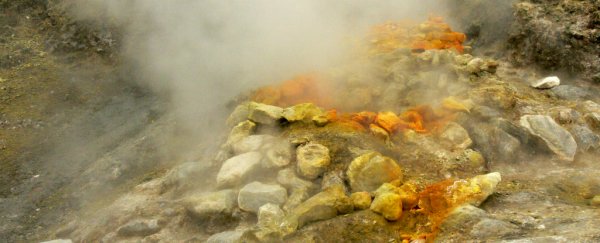Three people - an 11-year-old boy and his parents - died after they fell into boiling mud in a volcanic crater in Pozzuoli, an Italian city not far from Naples.
The family was visiting Solfatara, a shallow volcanic crater frequented by tourists, on Tuesday when the boy wandered into a restricted area and slipped into a nearly 10-foot (3-metre) deep pit, the Italian news agency ANSA reported. His father and mother fell into the hole trying to save him.
Another family member, a 7-year-old boy, was nearby and did not walk beyond the fenced-off area, authorities said. He was placed in the custody of social workers until his grandparents arrived.
Pozzuoli Mayor Vincenzo Figliolia voiced anguish at the tragedy.
"It's a moment of deep sadness for all of us," he said in a Facebook statement.
The victims, 42-year-old Tiziana Zaramella, 45-year-old Massimiliano Carrer and their son Lorenzo were visiting from Meolo, a town in northern Italy more than 400 miles (644 km) away, ANSA reported. Pictures showed crews carrying wooden coffins toward the victims' bodies, which lay on the ground several feet from the pit.
It was not clear whether they were killed because of the hot lava or whether they were overcome by the sulfurous fumes that the dormant volcano emits. Heavy rains may have played a role in creating openings on the crater's surface, according to the Associated Press.
Figliola declared Wednesday a day of grieving for the family. Flags will be flown at half-staff. He also urged schools and offices to observe a minute of silence at noon.
Witness Diego Vitagliano said he saw the 7-year-old boy crying and asking for help.
"I didn't think I would find myself confronted with the most brutal tragedy of my life. I, too, am a father. … I did not imagine that I would have seen such … I continue to think of the family and of the poor child who was crying and calling for help," Vitagliano, a pizza maker from Pozzuoli, told the newspaper la Repubblica.
The Solfatara crater is part of the Phlegraean Fields, locally known as Campi Flegrei (which means "burning fields"), a supervolcano dotted with several ancient volcanic craters and located west of Naples.
Though the Solfatara site is privately owned, geologists constantly monitor the area's temperatures and gases, the AP reports. Signs in multiple languages warn tourists of boiling temperatures and steam of up to 320 degrees Fahrenheit (160 degrees Celsius).
Campi Flegrei's last eruption occurred over the course of a week in 1538, the largest in European history. Scientists said last year that the volcano was nearing a crucial point and could erupt again, The Washington Post reported.
The Post's Sarah Kaplan wrote:
"Its caldera, the collapsed top of an ancient volcano that formed when the magma within erupted, is almost 8 miles [13 km] wide. Though half of the caldera is obscured beneath the crystal blue waters of the Mediterranean, the other half is on land studded with cinder cones and craters from smaller eruptions.
The whole area seethes with hydrothermal activity: Sulfuric acid spews from active fumaroles; geysers spout water and steam; the ground froths with boiling mud; and earthquake swarms shudder through the region, 125 miles [201 km] south of Rome."
2017 © The Washington Post
This article was originally published by The Washington Post.
